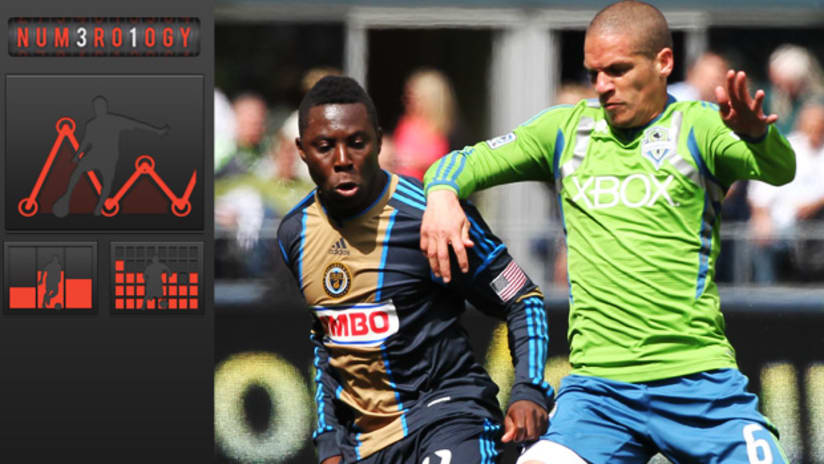"Americans love statistics." It's an old canard, and probably a true one.
It's an obsession that criss-crosses everyday life: social media, online traffic, box office numbers, presidential approval ratings. Statistical analysis is becoming more influential in all aspects of life.
From baseball, American sports fans are already quite aware of the "Sabermetric" revolution led by Billy Beane, general manager of Major League Baseball’s Oakland Athletics. Soccer teams across the globe are now following this model -- or will soon. Not just because competing with the likes of Manchester City, Chelsea and Real Madrid in the transfer market is unfeasible, but because it is a route to better soccer. It is in the best interest of both the game and the business.
adidas introduces miCoach System
In soccer there has been consistent growth in statistical analysis over the years, led by such stats-gathering companies as Opta (official stats provider for MLS), Match Analysis, and Prozone.
The stats companies are not alone. Adidas has recently launched the miCoach system, which will bring "smart soccer" to MLS though enhanced tracking of player movement and physiological data in real time.
They are all looking to assess performance through new and more relevant info, giving coaches contextualized data to compare potential signings with current team members, reserves with starters, rookies with veterans and so on. The comparisons can go player to player, team to team, and even league to league. In short, stats are a new evaluation tool -- not the end all be all, but a tool that's growing in stature and importance.
Statistics Telling Stories
Here’s an example of some key data points already gathered from the 2012 MLS season (through June 17):
Individual Statistics
- Tackles – Seattle's Osvaldo Alonso leads the league (71) for a second straight season, showing why people talk about him as the best holding midfielder in the league.
- Dribbles Attempted – Dallas's Fabian Castillo leads the league (76), revealing his attacking mentality, but his completion percentage is only 34 percent, well behind Sporting's Kei Kamara, who has the best completion rate of any player with at least 15 attempts (62 percent).
- Successful Passes – Kyle Beckerman leads the league for the second straight season. Little surprise given that he runs the midfield for the most pass-happy club in MLS (see below).
Team Statistics
- Total Passes – Unsurprisingly, league leaders RSL are tops in completed passes (5,317). Compare that to last-place Toronto FC, just 2,876.
- Pass-Completion Percentage – FC Dallas, winless in 10 straight, are at the bottom of the pass-completion percentage tables in the league (72 percent). While New York, Colorado, and RSL -- all teams in playoff position -- are at the top (80 percent).
- Shooting Accuracy – The Revolution hit the target only 41 percent of the time last year, and they finished well out of the playoff race. This year, they lead the league at 59 percent, and have a decent chance at a post-season berth.
League Statistics
- Pass-Completion Percentage -- The league pass-completion percentage is 76.5 percent, up a tick from last season.
- Total Passes -- Clubs are combining for an average of 825 passes per game, up from 776 in 2011. In short, teams are passing more.
- Shooting Accuracy -- MLS players are hitting the target with 45 percent of their shots, while only 42 percent of shots hit the target in the most recent Mexican Primera Division season.
Stats like these give coaches, scouts and the media greater insight into how players (and teams) not only see the game, but also whether performances are living up to expectations. Eventually, teams will be inclined to make more changes based on the data they are presented with. Right or wrong, teams can and will put more emphasis on statistics and analysis than they ever have in the past, and players, coaches and clubs will be held accountable (for good and bad).
How many times is a player giving the ball away in the attacking third? Who is that player passing to in the attacking third? Does that player have the vision and creativity to slot a successful through ball that puts a teammate in on goal? When he shoots, is he just blasting it, or is he picking his spot?
How does the last playoff team compare to the one that just missed the postseason? Why does one team consistently beat another?
How do the passing stats compare between MLS and other leagues? Does a player's performance in one league compare to his play in another?
And once the adidas miCoach Team System is available, we'll ask more questions, such as: How many times does a player perform at his top heart rate? How fast does a player move on the ball versus off the ball?
Analysis
In all, modern technology and analysis are evaluating every aspect of the game. At Opta, analysts log every single action in every game. But not every action is cut and dry. The question that often arises is: How do you define an action? What is a pass or a shot or a tackle? Or a missed pass or a missed shot? Did a player mis-hit a pass or did his target fail to control it? Did a defender tackle the ball away or did the dribbler lose it?
The pass, the fundamental building block of the game, is the perfect example. Not every pass is equal. Over the years, there have been significant advancements in tracking any given pass's importance. Now, a single pass can be categorized into several different subcategories: goal kick, free kick, corner kick, throw-in, GK kick from hands, launches, headers, chipped pass and pass are the most common actions. But there are also more nuanced modifiers, like lay-offs, pull backs, flick-ons (both by head and by foot) and through balls.
In all, it is there to provide as much detailed context as possible.
Applications
The various uses of next-generation stats make for an exciting future.
Content, such as the OPTA Spotlight and Central Winger columns on MLSsoccer.com, can show how all this data can be translated into comprehensible information, revealing some of the game's secrets to the casual fan through the use of statistically based charts and imagery. From a fan perspective, the broader stats are also bringing more depth to fantasy games. No longer is a soccer fantasy game based on just goals, shutouts, and games played. Now we can include defensive stats like CBIs (clearance, blocks, interceptions) and recoveries (winning the second ball). For attackers, crosses and BCC (big chance created) give points to players.
But the real benefit -- or hope -- is that advanced statistics will improve the level of play. Teams increasingly incorporate analytics during games, adjusting their tactics based on the available data, often in real time.
What does that mean? Below is the US national team’s tactical formation against Canada earlier this month. It shows where on the field the US players participated actively (i.e., touched the ball).

What we see is the team's overall shape in the first half looked rather promising: balanced, with the outside backs pushed high into the attack. But in the second half, the US overloaded the left side and were forced to drop more players in their own half to defend rather than attack. The final result shows that the US midfield was congested in the center while wing play, particularly on the right side, was nearly irrelevant.
This is not a guess. This is a graphical representation of every touch, every tackle, every foul committed by the US in that game. It's data, not interpretation.
There's tons more where that came from, by the way, all just waiting to be analyzed. The possibilities are endless.
Ben Jata writes the Fantasy Soccer: Manager column for MLSsoccer.com.











